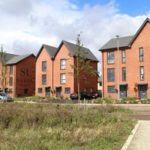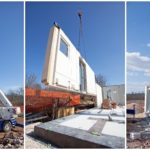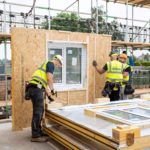News - Construction News
How to deliver true low carbon housing for the planet

In its 2019 Spring Statement the government said it will aim to end the use of fossil fuel-based heating systems in all new homes from 2025. It’s a bold move, and one that certainly brings even more focus on improving the sustainability credentials of the UK’s new-build housing stock. But what else should be done to make our homes truly low carbon and sustainable?
Going beyond operational efficiency
In the quest to reduce CO2 emissions and produce ‘nearly zero-carbon buildings’, most designers and builders focus on lowering operational emissions – even if it means emitting more CO2 in the construction process. There’s still very little thought put into reducing the CO2 emitted during the build stage and from the materials used in the building fabric itself.
There are, however, pockets of developments appearing across the UK that take a more holistic approach to sustainable housebuilding.
One such development currently under construction is Kings Farm Close. A collection of 15 new homes on the outskirts of the Oxfordshire village of Longcot, the development promises affordable, sensitively designed dwellings fit for 21st century living.
More significant, however, is that Kings Farm Close also claims to be the most sustainable housing development in Oxfordshire.
Modern methods of construction
Ian Pritchett, managing director of Oxfordshire-based Greencore Construction, has been championing a fabric-first approach to new home building, using eco-friendly, modern methods of construction for some time.
Every Greencore home is built offsite in a factory using a timber frame panel system, which is insulated with a mix of hemp, lime and wood fibre. The hemp-lime mix provides exceptional levels of thermal performance – tests carried out by Bath University showed that this system stores nearly four times the amount of heat when compared with traditional insulation materials like mineral wool.
Meeting the double carbon target
The insulated panel system – branded as the Biond Building System – is manufactured almost entirely from natural materials. It means that Greencore’s homes, which are always built to Passivhaus thermal performance standards, can achieve the double carbon target of a low carbon footprint and low operational energy usage.
Ultimately, it means the homes’ occupants won’t need to use their heating as often. This is because the hemp-lime and wood fibre insulation in the superstructure helps to maintain a comfortable indoor temperature all year round.
So, how is this possible? How does a humble plant-based insulation material like hemp-lime make such an impact on the thermal performance of a home?
Hemp-lime ‘phase change’ properties drive thermal efficiency
It’s all thanks to the natural ‘phase change’ properties of hemp-lime. The moisture naturally present in the cells of the hemp and in the pore spaces of the composite material can change from liquid to vapour and back again. When this change takes place, a lot of energy is either absorbed or released.
The reality is that the combination of good insulation and exceptional thermal inertia resulting from the natural phase change properties makes hemp-lime an extremely high performing material.
Recognition from sustainability leaders
In October 2018, Kings Farm Close was recognised by sustainability charity Bioregional for its national leadership in implementing One Planet Living, a comprehensive framework for planning, building and managing greener communities.
There’s a lot to be said for the power of plant-based materials in construction. The fact is the more of these materials we incorporate into buildings, the more carbon we lock up – plain and simple.
With construction work at Kings Farm Close expected to complete in the autumn of 2019, it won’t be long before the final residents move in and the claim of ‘Oxfordshire’s most sustainable housing development’ can be put to the test.
In conclusion, Ian said: “Greencore has been promoting the use of offsite construction for a long time now, and we build all our homes in our local factory using natural materials with low embodied carbon. Working in this way means our homes can be completed very quickly and to exceptionally high standards of quality control, all the while having a much lower impact on the environment.
“The Kings Farm Close project has allowed us to put into practice all our ideas and determination to create a genuinely sustainable community in Oxfordshire, where the same high performance standards are available to everyone, regardless of whether you’re renting or buying a home. We believe that all the residents will be able to enjoy greener and healthier lifestyles at Kings Farm Close, and we look forward to their feedback to help us with future projects.”
If you would like to read more articles like this then please click here.
Related Articles
More News
- Homes England acquires Ripon Barracks from MOD
3 Jul 25
Homes England has acquired land at Ripon Barracks which will be developed into 1,300 new
- University joins forces to address critical construction and housebuilding skills gap
2 Jul 25
The University of Salford is collaborating with Cube Thinking to support Barratt Homes in bridging the shift in skills requirements.
- Merit Appointed to NHS Shared Business Services Modular Building Framework
1 Jul 25
Merit is pleased to announce its successful appointment to the NHS Shared Business Services (NHS SBS)






